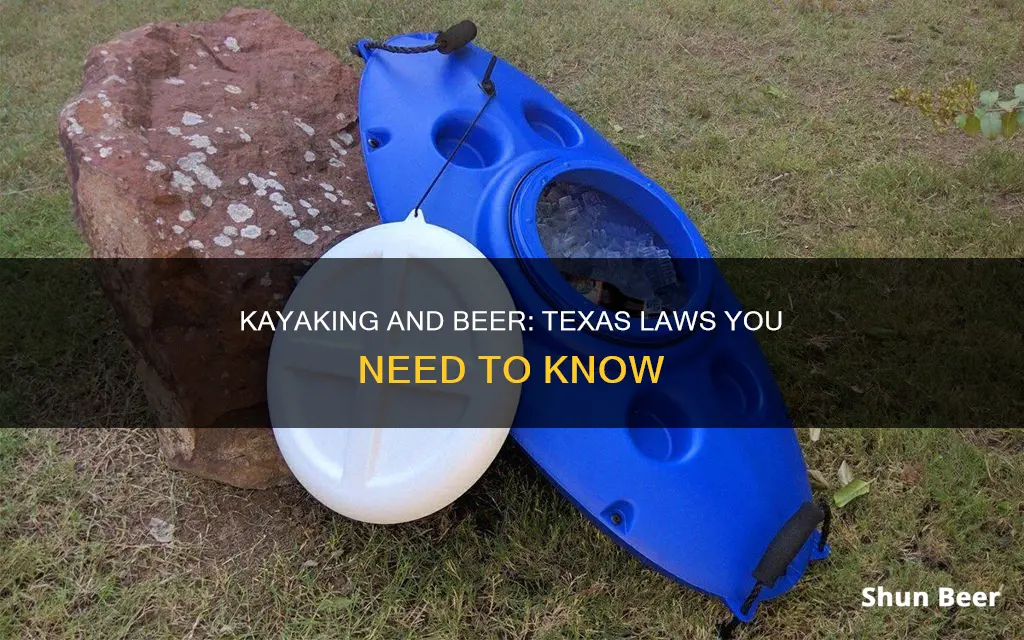
Texas is known for its abundant water sources, with over 7,000 lakes and the Gulf of Mexico on its border. Kayaking is a popular activity in the state, and it is important to be aware of the laws and regulations regarding alcohol consumption while kayaking. While it is legal to consume alcohol on a kayak in Texas, there are certain restrictions in place. Texas has strict laws against boating under the influence (BUI), and it is illegal to operate a kayak while intoxicated, with penalties including fines, jail time, and loss of boating and driving privileges. The blood alcohol limit for operating a kayak is the same as for driving a car, at 0.08%. It is recommended to always follow safety precautions, such as wearing a life jacket and avoiding drinking alcohol before or during handling firearms.
| Characteristics | Values |
|---|---|
| Is drinking beer on a kayak legal in Texas? | Yes, but only if you are a passenger and not operating the kayak. |
| Legal blood alcohol concentration (BAC) limit in Texas | 0.08 percent |
| Penalties for boating under the influence (BUI) in Texas | First offense: a fine of up to $2,000 and/or 180 days in jail |
| Second offense: a fine of up to $4,000 and/or 1 year in jail | |
| Third offense: a fine of up to $10,000 and/or 2 to 10 years in jail | |
| Texas's open container law on boats | It is legal to operate a boat with open cups, bottles, and cans of alcohol onboard. |
| Texas state laws for operating a kayak | A personal flotation device for each person, an efficient sound-signaling device, and a white light source visible from 360 degrees if paddling in reduced visibility or from sunset to sunrise are required. |
What You'll Learn
- Texas law prohibits operating a kayak while intoxicated, with penalties including fines and jail time
- Texas's open container law allows for open cups, bottles, and cans of alcohol on boats
- Texas law requires operators of paddlecraft to have a personal flotation device, an efficient sound-signalling device, and a white light source in certain conditions
- It is important to be mindful of powerboats on Texas's shared waterways and take steps to stay safe
- Alcohol is involved in the majority of fatal boating accidents, and it is ten times more likely to die in a boating accident with a BAC above 0.10

Texas law prohibits operating a kayak while intoxicated, with penalties including fines and jail time
Texas law prohibits operating a kayak or any other watercraft while intoxicated. The Texas Penal Code Section 49.06 states that it is an offence to be intoxicated while operating a watercraft, including kayaks, canoes, and motorized watercraft. The legal blood alcohol concentration (BAC) limit in Texas is 0.08 percent, and operating a kayak above this limit is illegal and can result in a person getting arrested for boating under the influence (BUI).
The penalties for a BUI in Texas can include fines, jail time, and the suspension or revocation of the individual's boater's and driver's licenses. For a first offence, an individual may face a fine of up to $2,000 and/or 180 days in jail. A second offence can result in a fine of up to $4,000 and/or one year in jail, while a third offence carries even harsher penalties, with a fine of up to $10,000 and/or two to ten years in jail.
While it is legal to consume alcohol as a passenger on a kayak or other watercraft in Texas, it is important to do so responsibly and in moderation. Operating a kayak while intoxicated not only increases the risk of accidents but can also lead to serious legal consequences, including fines and jail time. Therefore, it is crucial to abide by Texas law and refrain from operating a kayak or any other watercraft while under the influence of alcohol.
Beer and Bone Grafts: What You Need to Know
You may want to see also

Texas's open container law allows for open cups, bottles, and cans of alcohol on boats
Texas has a unique set of laws regarding alcohol consumption and boating, including kayaking. While drinking alcohol while operating a motor vehicle is illegal in Texas, the same does not apply to boats and water vessels. In fact, Texas's open container law explicitly permits open cups, bottles, and cans of alcohol on boats. This means that it is perfectly legal for both passengers and the operator of a kayak to consume alcohol, as long as they stay within the legal limit.
However, it is important to note that operating a kayak while intoxicated is illegal in Texas. The legal blood alcohol concentration (BAC) limit for operating a kayak is the same as for driving a car: 0.08%. If a kayaker is found to be operating their vessel under the influence of alcohol, they can face severe penalties, including fines, jail time, and the loss of their boating and driving privileges.
While Texas law allows for alcohol consumption on kayaks, it is crucial to prioritise safety and responsibility. Kayaking, especially in dynamic river systems, comes with inherent dangers. It is recommended to always wear a personal flotation device, carry a sound-signalling device, and have a 360-degree visible light source when paddling in reduced visibility or at night. Additionally, factors like sun damage and fatigue can make it easier to appear intoxicated, even if one is not. Therefore, it is essential to be mindful of alcohol consumption and stay within legal limits.
In conclusion, Texas's open container law permits open alcohol containers on boats, including kayaks. However, it is illegal to operate a kayak while intoxicated, and safety should always be a top priority.
Mixing Beer and Vodka: A Safe Night Out?
You may want to see also

Texas law requires operators of paddlecraft to have a personal flotation device, an efficient sound-signalling device, and a white light source in certain conditions
Firstly, a personal flotation device (PFD) is essential for each person aboard the vessel. The Texas Parks and Wildlife Department recommends a USCG-approved Type III-V PFD, which can provide adequate buoyancy and support in the event of an accident or sudden immersion in water.
Secondly, an efficient sound-signalling device is required. This can be a simple whistle, which allows operators to alert others in the event of an emergency or to signal their presence to nearby boats or paddlecraft.
Lastly, a white light source is required if paddling in reduced visibility conditions or during the hours between sunset and sunrise. This light should be visible from 360 degrees, ensuring that the paddlecraft can be seen by other vessels in the area.
In addition to these requirements, the Texas Parks and Wildlife Department also recommends several safety tips for paddlecraft operators. These include filing a "float plan" by informing someone of your intended route and expected return time, checking weather forecasts, carrying a map or chart of the area, and having a means of communication such as a cell phone or VHF radio.
It is important to note that while drinking alcohol is legal in Texas for those of legal age, operating a paddlecraft while intoxicated is against the law. Texas has strict regulations regarding boating while intoxicated, and operators found to be under the influence of alcohol or drugs can face severe penalties, including fines, jail time, and the loss of boating and driving privileges.
Drinking Beer at Whole Foods: What You Need to Know
You may want to see also

It is important to be mindful of powerboats on Texas's shared waterways and take steps to stay safe
Texas laws regarding drinking alcohol while kayaking are ambiguous. While some sources suggest that it is illegal to operate any watercraft while under the influence, others claim that a kayak would not qualify as a watercraft since it is not motorized. However, regardless of the legal ambiguity, it is important to prioritize safety when sharing Texas waterways with powerboats.
- Always wear a life jacket: This is crucial for your safety, and it is also a legal requirement for children under 13 years of age.
- Enroll in a boating safety course: Educate yourself on the rules and courtesies of the waterways. The U.S. Coast Guard recommends taking a boating safety course to learn essential safety practices.
- Be alert and mindful of other boaters: Remember that you share the waterways with powerboats, sailboats, and personal watercraft (PWCs). Be especially cautious around PWCs and maintain a safe distance from them.
- Operate at a safe speed: Use common sense and operate at a speed that is reasonable and prudent, taking into account the conditions and hazards around you.
- Designate a sober person: If you plan on drinking, ensure that there is a designated sober operator for your kayak who can navigate safely.
- Follow safety protocols: Conduct a pre-departure check, ensure proper functioning of steering, throttle controls, lights, and safety equipment, and be mindful of fuel leaks and engine compartment leaks.
- Be mindful of your surroundings: Stay alert and aware of your surroundings, including nearby powerboats. Maintain a proper lookout and be prepared to react to dangerous situations.
- Avoid drinking and driving: Even if you are within the legal blood alcohol limit, do not operate a motor vehicle after drinking. The probability of being killed in a boating accident doubles when alcohol is involved.
By following these safety precautions, you can help ensure a safe and enjoyable experience on Texas waterways while sharing the space with powerboats.
Beer and College Football: A Match Made in Heaven?
You may want to see also

Alcohol is involved in the majority of fatal boating accidents, and it is ten times more likely to die in a boating accident with a BAC above 0.10
In Texas, there are rules and regulations that govern drinking alcohol while kayaking. While it is not illegal to drink beer on a kayak, it is illegal to operate any watercraft while under the influence of drugs or alcohol. This includes kayaks, as they fall under the definition of a watercraft in Texas. The blood alcohol limit for operating a kayak is the same as for driving a car, at 0.08%. If you are caught operating a kayak while intoxicated, you may face severe penalties, including fines, jail time, loss of boating privileges, and even impoundment of your kayak.
Alcohol is often involved in fatal boating accidents. Worldwide, alcohol consumption played a causal role in 298,000 road crash deaths in 2019, with 156,000 of these caused by someone else's drinking. In the United States, alcohol is a factor in 15% of robberies, 63% of intimate partner violence incidents, 37% of sexual assaults, 45-46% of physical assaults, and 40-45% of homicides. Additionally, 54% of violent crime perpetrators were found to have been consuming alcohol before their offenses.
When it comes to boating accidents specifically, studies have shown that most alcohol-related fatalities involve repeat drinking drivers. Alcohol impairs judgment and lowers inhibitions, increasing the likelihood of risky behaviour. This can lead to accidents and more serious crimes. It is important to note that even low levels of alcohol consumption carry risks and can cause harm. The risk of accidents and negative outcomes increases with higher levels of alcohol consumption.
To stay safe while drinking beer on a kayak in Texas, it is crucial to drink responsibly and within the limits set by state laws. Always have a designated driver or sober operator for your kayak. Additionally, never operate any watercraft while under the influence of drugs or alcohol. By following these precautions, you can enjoy a safe and enjoyable kayaking experience while sipping on a cold beer.
Post-Massage Beer: Is It Safe to Drink Alcohol?
You may want to see also
Frequently asked questions
It is legal to drink beer while kayaking in Texas, but it is illegal to operate a kayak while intoxicated. The blood alcohol limit for operating a kayak is the same as it is for driving a car: 0.08%.
If you are caught operating a kayak while intoxicated, you can face severe penalties, including a fine of up to $2,000 and/or 180 days in jail for a first offense, and increasing penalties for subsequent offenses.
It is recommended to always file a float plan, check weather forecasts, carry a map or GPS, wear protective footgear, and bring drinking water, sunscreen, and insect repellent.
It is legal to consume alcohol while on a boat in Texas, but it is illegal for the operator of the boat to be intoxicated. The same blood alcohol limit of 0.08% applies.







